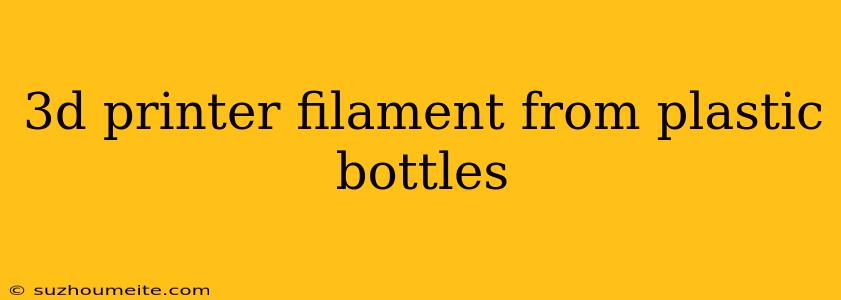3D Printer Filament from Plastic Bottles: A Sustainable Revolution
The world of 3D printing has been rapidly evolving, and one of the most exciting developments is the creation of 3D printer filament from plastic bottles. This innovative approach not only reduces waste but also provides a sustainable and affordable solution for 3D printing enthusiasts. In this article, we'll delve into the process of creating 3D printer filament from plastic bottles and explore its benefits and implications.
The Problem of Plastic Waste
Plastic waste has become a significant environmental concern, with millions of plastic bottles ending up in landfills and oceans every year. According to the United Nations, if we don't take immediate action, there will be more plastic than fish in the ocean by 2050. The production of plastic bottles requires massive amounts of fossil fuels, contributing to greenhouse gas emissions and climate change.
The Solution: Converting Plastic Bottles into 3D Printer Filament
A group of innovative individuals has developed a method to convert plastic bottles into 3D printer filament. This process involves collecting plastic bottles, cleaning and sorting them, and then shredding them into small pieces. The shredded plastic is then melted and extruded into a filament form, which can be used in 3D printers.
Benefits of Using Recycled Plastic Filament
The benefits of using recycled plastic filament are numerous:
- Sustainability: By using recycled plastic, we reduce the amount of waste that ends up in landfills and oceans.
- Cost-effective: Recycled plastic filament is significantly cheaper than traditional filament materials, making 3D printing more accessible to everyone.
- Reduced carbon footprint: The production of recycled plastic filament requires less energy than traditional filament production, reducing greenhouse gas emissions.
The Process of Creating Recycled Plastic Filament
The process of creating recycled plastic filament involves several steps:
- Collection: Plastic bottles are collected from recycling centers, waste management facilities, and community collections.
- Cleaning and sorting: The collected plastic bottles are cleaned and sorted according to their type and color.
- Shredding: The sorted plastic is shredded into small pieces to increase its surface area.
- Melting and extrusion: The shredded plastic is melted and extruded through a machine, creating a long, thin strand of filament.
- Winding and spooling: The filament is wound onto a spool, ready for use in 3D printers.
Challenges and Limitations
While the concept of creating 3D printer filament from plastic bottles is groundbreaking, there are some challenges and limitations to consider:
- Quality control: Ensuring the quality of the recycled plastic filament is crucial to ensure consistent 3D printing results.
- Scalability: Currently, the production of recycled plastic filament is limited in scale, making it challenging to meet the demands of the 3D printing community.
- Color consistency: The color of the recycled plastic filament may vary depending on the type of plastic bottles used, which can affect the aesthetic appeal of the final product.
Conclusion
The creation of 3D printer filament from plastic bottles is a revolutionary concept that has the potential to transform the 3D printing industry. By using recycled plastic filament, we can reduce waste, decrease greenhouse gas emissions, and make 3D printing more accessible to everyone. While there are challenges to overcome, the benefits of this innovative approach make it an exciting development worth exploring further. As the world continues to grapple with the plastic waste crisis, this sustainable solution offers a glimmer of hope for a more environmentally friendly future.
